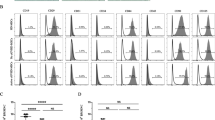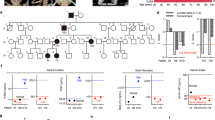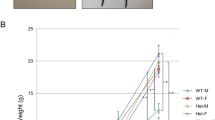Abstract
The positive roles of the Wnt/β-catenin pathway in osteoblast differentiation and bone mineral density (BMD) maintenance have been clearly demonstrated in both animal experiments and clinical investigations. CXXC finger protein 5 (CXXC5), a recently identified negative regulator of the Wnt/β-catenin pathway, showed altered cellular localization and function, which were dependent on the cell type in previous studies. However, the in vivo function of CXXC5 has not been clearly investigated yet. Here, we characterized CXXC5 as a negative regulator of osteoblast differentiation and bone formation. Deficiency of CXXC5 resulted in elevated BMD in mice without any severe gross developmental abnormalities. CXXC5 exerted a negative-feedback effect on the Wnt/β-catenin pathway via Wnt-dependent binding to Dishevelled (Dvl) during osteoblast differentiation. Suppression of the Dvl–CXXC5 interaction using a competitor peptide resulted in the activation of the Wnt/β-catenin pathway and osteoblast differentiation, and accelerated thickness growth of ex vivo-cultured calvariae. Overall, CXXC5 is a negative-feedback regulator induced by Wnt/β-catenin signaling that inhibits osteoblast differentiation and bone formation via interaction with Dvl.
Similar content being viewed by others
Log in or create a free account to read this content
Gain free access to this article, as well as selected content from this journal and more on nature.com
or
Abbreviations
- α-MEM:
-
α-minimal essential medium
- ALP:
-
alkaline phosphatase
- BMD:
-
bone mineral density
- BSP:
-
bone sialoprotein
- CT:
-
computed tomography
- DAB:
-
3,3′-diaminobenzidine
- DBM:
-
Dvl-binding motif
- DMP-1:
-
dentin matrix acidic phosphoprotein-1
- Dvl:
-
Dishevelled
- Fgf18:
-
fibroblast growth factor 18
- H&E:
-
hematoxylin and eosin
- PTD:
-
protein transduction domain
References
Eriksen EF . Cellular mechanisms of bone remodeling. Rev Endocr Metab Disord 2010; 11: 219–227.
Long F . Building strong bones: molecular regulation of the osteoblast lineage. Nat Rev Mol Cell Biol 2012; 13: 27–38.
Rachner TD, Khosla S, Hofbauer LC . Osteoporosis: now and the future. Lancet 2011; 377: 1276–1287.
Regard JB, Zhong Z, Williams BO, Yang Y . Wnt signaling in bone development and disease: making stronger bone with Wnts. Cold Spring Harb Perspect Biol 2012; 4: 1–17.
Hoeppner LH, Secreto FJ, Westendorf JJ . Wnt signaling as a therapeutic target for bone diseases. Expert Opin Ther Targets 2009; 13: 485–496.
Ravasi T, Huber T, Zavolan M, Forrest A, Gaasterland T, Grimmond S et al. Systematic characterization of the zinc-finger-containing proteins in the mouse transcriptome. Genome Res 2003; 13: 1430–1442.
Pendino F, Nguyen E, Jonassen I, Dysvik B, Azouz A, Lanotte M et al. Functional involvement of RINF, retinoid-inducible nuclear factor (CXXC5), in normal and tumoral human myelopoiesis. Blood 2009; 113: 3172–3181.
Kim HY, Yang DH, Shin SW, Kim MY, Yoon JH, Kim S et al. CXXC5 is a transcriptional activator of Flk-1 and mediates bone morphogenic protein-induced endothelial cell differentiation and vessel formation. FASEB J 2014; 28: 615–626.
Andersson T, Södersten E, Duckworth JK, Cascante A, Fritz N, Sacchetti P et al. CXXC5 is a novel BMP4-regulated modulator of Wnt signaling in neural stem cells. J Biol Chem 2009; 284: 3672–3681.
Hino S, Kishida S, Michiue T, Fukui A, Sakamoto I, Takada S et al. Inhibition of the Wnt signaling pathway by Idax, a novel Dvl-binding protein. Mol Cell Biol 2001; 21: 330–342.
Qin C, D'Souza R, Feng JQ . Dentin matrix protein 1 (DMP1): new and important roles for biomineralization and phosphate homeostasis. J Dent Res 2007; 86: 1134–1141.
Bonewald LF, Johnson ML . Osteocytes, mechanosensing and Wnt signaling. Bone 2008; 42: 606–615.
Stuart AJ, Smith DA . Use of the fluorochromes xylenol orange, calcein green, and tetracycline to document bone deposition and remodeling in healing fractures in chickens. Avian Dis 1992; 36: 447–449.
Wang D, Christensen K, Chawla K, Xiao G, Krebsbach PH, Franceschi RT et al. Isolation and characterization of MC3T3-E1 preosteoblast subclones with distinct in vitro and in vivo differentiation/mineralization potential. J Bone Miner Res 1999; 14: 893–903.
Reinhold MI, Naski MC . Direct interactions of Runx2 and canonical Wnt signaling induce FGF18. J Biol Chem 2007; 282: 3653–3663.
He TC, Sparks AB, Rago C, Hermeking H, Zawel L, da Costa LT et al. Identification of c-MYC as a target of the APC pathway. Science 1998; 281: 1509–1512.
Shtutman M, Zhurinsky J, Simcha I, Albanese C, D'Amico M, Pestell R et al. The cyclin D1 gene is a target of the beta-catenin/LEF-1 pathway. Proc Natl Acad Sci USA 1999; 96: 5522–5527.
London TB, Lee HJ, Shao Y, Zheng J . Interaction between the internal motif KTXXXI of Idax and mDvl PDZ domain. Biochem Biophys Res Commun 2004; 322: 326–332.
Matsushita M, Matsui H . Protein transduction technology. J Mol Med 2005; 83: 324–328.
Reynolds JJ, Minkin C, Morgan DB, Spycher D, Fleisch H . The effect of two diphosphonates on the resorption of mouse calvaria in vitro. Calcif Tissue Res 1972; 10: 302–313.
Canalis E, Giustina A, Bilezikian JP . Mechanisms of anabolic therapies for osteoporosis. N Engl J Med 2007; 357: 905–916.
Li X, Zhang Y, Kang H, Liu W, Liu P, Zhang J et al. Sclerostin binds to LRP5/6 and antagonizes canonical Wnt signaling. J Biol Chem 2005; 280: 19883–19887.
Vashishth D, Verborgt O, Divine G, Schaffler MB, Fyhrie DP . Decline in osteocyte lacunar density in human cortical bone is associated with accumulation of microcracks with age. Bone 2000; 26: 375–380.
Parfitt AM, Drezner MK, Glorieux FH, Kanis JA, Malluche H, Meunier PJ et al. Bone histomorphometry: standardization of nomenclature, symbols, and units. Report of the ASBMR Histomorphometry Nomenclature Committee. J Bone Miner Res 1987; 2: 595–610.
Acknowledgements
We thank Sean Bong Lee and Ho Jin Lee for their helpful discussion and comments on the manuscript. This work was funded by the Ministry of Future Creation and Science (MFCS) of Korea; Translational Research Center for Protein Function Control (2009-0083522), Mid-career Researcher Program (2012-010285) and Stem Cell Research Project (2010-0020235). This work was also supported by the Ministry of Knowledge Economy (through the Korea Research Institute of Chemical Technology (SI-0905, SI-1005, SI-1105, SI-1205 and SI-1304)). H-YK, J-YY, S-HL and K-WC were supported by a BK21 studentship from the NRF and the MFCS.
Author information
Authors and Affiliations
Corresponding author
Ethics declarations
Competing interests
The authors declare no conflict of interest.
Additional information
Edited by H-U Simon
Supplementary Information accompanies this paper on Cell Death and Differentiation website
Supplementary information
Rights and permissions
About this article
Cite this article
Kim, HY., Yoon, JY., Yun, JH. et al. CXXC5 is a negative-feedback regulator of the Wnt/β-catenin pathway involved in osteoblast differentiation. Cell Death Differ 22, 912–920 (2015). https://doi.org/10.1038/cdd.2014.238
Received:
Revised:
Accepted:
Published:
Issue date:
DOI: https://doi.org/10.1038/cdd.2014.238
This article is cited by
-
CXXC5 mitigates P. gingivalis-inhibited cementogenesis by influencing mitochondrial biogenesis
Cell Communication and Signaling (2024)
-
Inhibiting the cytosolic function of CXXC5 accelerates diabetic wound healing by enhancing angiogenesis and skin repair
Experimental & Molecular Medicine (2023)
-
Long non-coding RNAs in osteoporosis: from mechanisms of action to therapeutic potential
Human Cell (2023)
-
Exopolysaccharide of Enterococcus faecium L15 promotes the osteogenic differentiation of human dental pulp stem cells via p38 MAPK pathway
Stem Cell Research & Therapy (2022)
-
Blockade of CXXC5-dishevelled interaction inhibits adipogenic differentiation, obesity, and insulin resistance in mice
Scientific Reports (2022)



